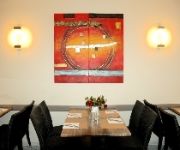Facts and Data
Webpages:
Official Unesco Page
Les Causes et les Cévennes paysage culturel de l'agro-pastoralisme
Basis Data:
Unesco World heritage since: 2011
Size of heritage: 302,319 ha
- Buffer zone: 312,425 ha
Coordinates:
Longitude: 3,473°
Latitude: 44,220°
Summary
This 302,319 ha property, in the southern part of central France, is a mountain landscape interspersed by deep valleys that is representative of the relationship between agro-pastoral systems and their biophysical environment, notably through drailles or drove roads. Villages and substantial stone farmhouses on deep terraces of the Causses reflect the organization of large abbeys from the 11th century. Mont Lozère, inside the property, is one of the last places where summer transhumance is still practiced in the traditional way, using the drailles.
Location on Map
Show bigger map on Openstreetmap
The Causses and the Cévennes, Mediterranean agro-pastoral Cultural Landscape
The Causses and the Cévennes, Mediterranean agro-pastoral Cultural Landscape is a UNESCO World Heritage site located in the southern part of France. This cultural landscape covers an area of approximately 3,000 square kilometers and is characterized by its unique combination of natural and cultural elements.
History
The history of the Causses and the Cévennes dates back thousands of years. The area has been inhabited since prehistoric times, and evidence of human presence can be found in the numerous dolmens, menhirs, and other megalithic structures scattered throughout the landscape.
During the Roman period, the region was an important center for agriculture and trade. The Romans introduced new agricultural techniques and built extensive networks of roads and aqueducts to support their settlements. Many of these ancient structures can still be seen today, providing valuable insights into the region's past.
In the Middle Ages, the Causses and the Cévennes became a stronghold of the Cathars, a religious group that challenged the authority of the Catholic Church. The region was the site of numerous conflicts and was eventually incorporated into the Kingdom of France in the 13th century.
Over the centuries, the local population developed a unique agro-pastoral system that is still practiced today. This system involves the cultivation of crops such as wheat, barley, and rye on the fertile valley floors, while the limestone plateaus, known as causses, are used for grazing livestock, particularly sheep.
Current State
The Causses and the Cévennes, Mediterranean agro-pastoral Cultural Landscape is a living testament to the traditional practices and way of life of the local population. The landscape is dotted with small villages, farms, and terraced fields, all of which contribute to the unique character of the region.
However, the cultural landscape faces several challenges in the modern era. Changes in agricultural practices, urbanization, and the decline of traditional industries have all had an impact on the region. The abandonment of traditional farming methods has led to the loss of biodiversity and the degradation of the landscape.
To address these challenges, various conservation and preservation efforts have been undertaken. The local communities, along with national and international organizations, have worked together to promote sustainable agriculture, protect natural habitats, and raise awareness about the importance of preserving the cultural heritage of the region.
Today, the Causses and the Cévennes, Mediterranean agro-pastoral Cultural Landscape continues to be a vibrant and dynamic area. It attracts visitors from around the world who come to explore its natural beauty, learn about its rich history, and experience the unique way of life of the local population.
As a UNESCO World Heritage site, the Causses and the Cévennes serves as a model for the sustainable management of cultural landscapes. It demonstrates the importance of preserving traditional practices and promoting the harmonious coexistence of humans and nature.
In conclusion, the Causses and the Cévennes, Mediterranean agro-pastoral Cultural Landscape is a remarkable site that showcases the deep connection between humans and their environment. Its rich history, unique cultural practices, and stunning natural beauty make it a truly exceptional place that deserves its UNESCO World Heritage status.






